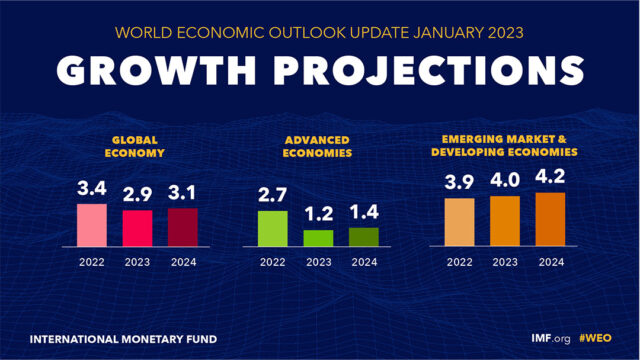- IMF’s chief economist forecasts global growth will slow from 3.4% in 2022 to 2.9% in 2023 and rebound to 3.1% in 2024
- Pierre-Olivier Gourinchas says despite headwinds from the fight against inflation and the Ukraine war, the outlook is less gloomy than in his October forecast
- He says the fight against inflation is starting to pay off, but central banks must continue their efforts to tame it
The International Monetary Fund has increased slightly its growth projections for the global economy in 2022 and 2023, saying the outlook this year is less gloomy than the Fund had forecast last October.
Global growth is projected to fall from an estimated 3.4 percent in 2022 to 2.9 percent in 2023, then rise to 3.1 percent in 2024. The forecast for 2023 is 0.2 percentage point higher than predicted in the October 2022 World Economic Outlook (WEO) but below the historical (2000–19) average of 3.8 percent.
IMF chief economist Pierre-Olivier Gourinchas said despite the headwinds from the fight against inflation and Russia’s war on Ukraine, the outlook is less gloomy than in his October forecast. He said it could represent a turning point, with growth bottoming out and inflation declining.
Gourinchas, summarizing the Fund’s outlook in an IMF blog post on January 30, said that for advanced economies, the slowdown will be more pronounced, with a decline from 2.7% last year to 1.2% and 1.4% this year and next. Nine out of 10 advanced economies are likely to decelerate.
He said US growth will slow to 1.4% in 2023 as Federal Reserve interest-rate hikes work their way through the economy. Euro area conditions are more challenging despite signs of resilience to the energy crisis, a mild winter, and generous fiscal support, he said.
With the European Central Bank tightening monetary policy and a negative terms-of-trade shock, he expects growth to bottom out at 0.7% this year.
Emerging market and developing economies have already bottomed out as a group, with growth expected to rise modestly to 4% and 4.2% this year and next, Gourinchas said.
In China, restrictions and COVID-19 outbreaks dampened activity last year, but with the economy now reopened, growth should rebound to 5.2% this year as activity and mobility recover, he said.
India remains a bright spot, said Gourinchas. Together with China, it will account for half of global growth this year, versus just a tenth for the US and euro area combined. Global inflation is expected to decline this year, but even by 2024, projected average annual headline and core inflation will still be above pre-pandemic levels in over 80% of countries.
Gourinchas said the global economy will slow this year before rebounding next year. Growth will remain weak as the fight against inflation and Russia’s war in Ukraine weigh on activity.
He said China’s sudden re-opening paves the way for a rapid rebound in activity. And global financial conditions have improved as inflation pressures have started to abate. This, and a weakening of the US dollar from its November high, provided some modest relief to emerging and developing countries.
He expects global inflation to fall this year but, even by 2024, projected average annual headline and core inflation will still be above pre-pandemic levels in more than 80% of countries.
Despite the slightly upbeat forecasts, the IMF view the risks to the outlook as still being tilted to the downside, even if adverse risks have moderated since October.
On the downside, Gourinchas said China’s recovery could stall amid greater-than-expected economic disruptions from current or future COVID-19 resurgence or a sharper-than-expected property tumble. Also, inflation could stay stubbornly high amid labor-market tightness and growing wage pressures.
A Ukraine war escalation remains a major threat to stability that could destabilize energy or food markets and further fragment the global economy. A sudden repricing in financial markets could tighten financial conditions, especially in emerging markets and developing economies.
On the upside, strong household balance sheets, together with tight labor markets and solid wage growth, could sustain private demand. Easing supply-chain bottlenecks and labor markets cooling due to falling vacancies could allow for a softer landing.
Policy priorities are in taming inflation. Where inflation pressures remain too high, central banks should raise real policy rates above the neutral rate and keep them there until underlying inflation decisively declines. Easing too early risks undoing all the gains achieved so far, Gourinchas said.
Many countries responded to the cost-of-living crisis by supporting people and businesses with broad and untargeted policies that helped cushion the shock. Countries should instead adopt targeted measures that conserve fiscal space, allow high energy prices to reduce demand for energy, and avoid overly stimulating the economy.
Supply-side policies also have a role to play. They can help remove key growth constraints, improve resilience, ease price pressures, and foster the green transition.
“Finally, the forces of geoeconomic fragmentation are growing. We must buttress multilateral cooperation, especially on fundamental areas of common interest such as international trade, expanding the global financial safety net, public health preparedness and the climate transition,” Gourinchas said.









